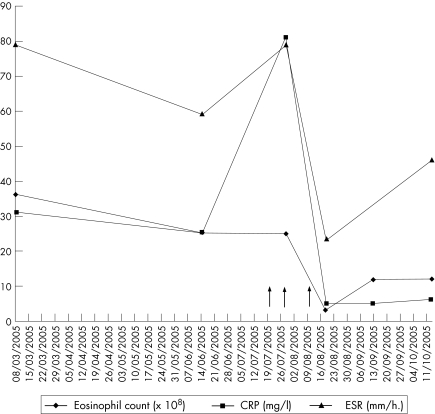Churg‐Strauss syndrome (CSS) is a disorder characterised by hypereosinophilia and systemic vasculitis occurring in people with asthma and allergic rhinitis. Corticosteroids in combination with a cytotoxic agent are the most effective treatment for CSS. Rituximab, a genetically engineered chimeric anti‐CD20 monoclonal antibody has recently been tried with favourable responses in chronic immunological diseases.1 Several published reports have shown its effectiveness in ANCA mediated vasculitides.2,3 We present a patient with CSS who responded well to rituximab after conventional treatments had failed.
A 49 year old, white male patient with a long history of asthma presented in 2000 with inflammatory polyarthritis, bilateral scleritis, and negative autoantibodies. He was managed as a patient with seronegative RA but was intolerant to methotrexate and sulfasalazine. His symptoms settled, only to recur in 2004 with polyarthralgia, vasculitic skin rash (fig 1), dyspnoea, microscopic haematuria, and mild proteinuria.
Figure 1 Skin vasculitic changes before (above) and after (below) treatment with rituximab.
Repeat investigations showed a high absolute eosinophil count of 4×109/l, raised erythrocyte sedimentation rate (ESR) of 120 mm/1st h, and C reactive protein (CRP) of 181 mg/l, mildly raised creatinine, and a positive cANCA (anti‐proteinase 3 (PR3) titre of 30 (normal <2)). High resolution computed tomography of his chest showed pulmonary infiltrates consistent with pulmonary vasculitis. A nasal biopsy showed chronic inflammation, with some areas suggestive of vasculitis, and eosinophilic infiltration. His skin biopsy showed leucocytoclastic vasculitis, and a renal biopsy disclosed minimal non‐specific abnormalities. Based on the above,4 a diagnosis of CSS was made and treatment was started with prednisolone 40 mg and azathioprine.
His initial response was not sustained, requiring a change to cyclophosphamide in January 2005. Despite fortnightly pulses of cyclophosphamide (15 mg/kg) for 5 months, his condition continued to deteriorate. At this point, after reviewing the available publications on the use of rituximab in ANCA associated vasculitis,2,3 treatment was started with this drug. Although it was planned as a 4 week regimen at 700 mg/week (375 mg/m2 body surface area) with 100 mg intravenous methylprednisolone,2 he required hospital admission after the second infusion, with bronchopneumonia and herpes zoster. This was treated appropriately, and his third infusion was given as a bolus on the 4th week (1 g). After this, his skin vasculitis cleared completely (fig 1) with normal ESR, CRP, absolute eosinophil count, anti‐PR3 titres (fig 2), and undetectable B cells with normal T cell markers. He has been seen fortnightly since then (nearly 3 months), with no recurrence of skin vasculitis. Small increases in his eosinophil count ((0.5–1.5) × 109/l) have occurred and treatment with oral prednisolone at a dose of 30 mg a day is continuing.
Figure 2 Changes to inflammatory markers and eosinophil count with rituximab (indicated by arrows)
Based on the above, rituximab appears to be a promising treatment for induction of remission in CSS. The rationale behind the use of rituximab is based on three assumptions5: (a) ANCA has an important role in the pathogenesis of ANCA associated vasculitides; (b) treatment with rituximab can effectively deplete CD20 expressing precursors of ANCA‐producing plasma cells; and (c) plasma cells producing ANCA are short lived, and transient depletion of their CD20+ precursors will abrogate ANCA production. However, we need to be aware of the concurrent risks of robust immunosuppression and predisposition to serious infections. Further research is warranted into the maintenance of remission and the long term safety with rituximab use.
Footnotes
Accepted 17 March 2006
Conflict of interest: None
References
- 1.Omdal R, Wildhagen K, Hansen T, Gunnarsson R, Kristoffersen G. Anti‐CD20 therapy of treatment‐resistant Wegener's granulomatosis: favourable but temporary response. Scand J Rheumatol 200534229–232. [DOI] [PubMed] [Google Scholar]
- 2.Eriksson P. Nine patients with anti‐neutrophil cytoplasmic antibody‐positive vasculitis successfully treated with rituximab. J Intern Med 2005257(540–548. [DOI] [PubMed] [Google Scholar]
- 3.Specks U, Fervenza F C, McDonald T J, Hogan M C. Response of Wegener's granulomatosis to anti‐CD20 chimeric monoclonal antibody therapy. Arthritis Rheum 2001442836–2840. [DOI] [PubMed] [Google Scholar]
- 4.Masi A T, Hunder G G, Lie J T, Michel B A, Bloch D A, Arend W P.et al The American College of Rheumatology 1990 criteria for the classification of Churg‐Strauss syndrome (allergic granulomatosis and angiitis). Arthritis Rheum 1990331094–1100. [DOI] [PubMed] [Google Scholar]
- 5.Sneller M C. Rituximab and Wegener's granulomatosis: are B cells a target in vasculitis treatment? Arthritis Rheum 2005521–5. [DOI] [PubMed] [Google Scholar]




